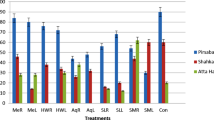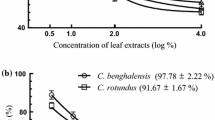Abstract
Weeds infestation poses huge threat to agricultural crop production systems and their management in modern agriculture. It is imperative to reduce yield losses and ensure food security. In order to minimize herbicide application, a study was carried out to evaluate the allelopathic potential of leaves extracts tested on weed suppression in wheat crop under rainfed conditions. Leaves extracts of Moringa oleifera, Parthenium hystorophorus and Cannabis sativa alone and in different combinations along with a control (distilled water) were sprayed to explore the allelopathic potential for weed management in wheat-maize cropping system. Foliar application of moringa + parthenium + cannabis leaves extract was the best treatment to reduce the number of leaves, leaf length and shoot length of all tested weed species. Leaf chlorophyll content and photosynthetic rate of weed plants was significantly reduced under exogenously application of leaf extracts. Various phenolic compounds were also detected in parthenium, cannabis and moringa leaf extracts. Maximum phenolic compounds were found in parthenium followed by cannabis and moringa leaf extracts. The combination of leaf extracts of Moringa oleifera (MLE) with Parthenium hysterophorus (PLE) and Cannabis sativa (CLE) (water extract at 3%) was significantly impactful to suppress weeds in wheat and achieve higher wheat growth.
Zusammenfassung
Unkrautbefall stellt eine enorme Bedrohung für die landwirtschaftlichen Pflanzenproduktionssysteme und deren Management in der modernen Landwirtschaft dar. Es ist unerlässlich, Ertragsverluste zu verringern und die Ernährungssicherheit zu gewährleisten. Um den Herbizideinsatz zu minimieren, wurde eine Studie zur Bewertung des allelopathischen Potenzials von Blattextrakten durchgeführt, die zur Unkrautunterdrückung in Weizenkulturen bei Regenfeldanbau getestet wurden. Blattextrakte von Moringa oleifera, Parthenium hystorophorus und Cannabis sativa wurden einzeln und in verschiedenen Kombinationen zusammen mit einer Kontrolle (destilliertes Wasser) versprüht, um das allelopathische Potenzial für die Unkrautbekämpfung im Weizen-Maisanbau zu untersuchen. Die Behandlung mit Moringa- + Parthenium- + Cannabisblattextrakt war die beste Behandlung, um die Anzahl der Blätter, die Blattlänge und die Sprosslänge aller getesteten Unkrautarten zu reduzieren. Der Blattchlorophyllgehalt und die Photosyntheserate der Unkrautpflanzen wurde unter exogener Applikation der Blattextrakte signifikant reduziert. Verschiedene phenolische Verbindungen wurden in Parthenium‑, Cannabis- und Moringa-Blattextrakten nachgewiesen. Das Maximum an phenolischen Verbindungen wurde in Partheniumextrakten gefunden, gefolgt von Cannabis- und Moringa-Blattextrakten. Die Kombination von Blattextrakten von Moringa oleifera (MLE) mit Parthenium hysterophorus (PLE) und Cannabis sativa (CLE) (3%iger wässriger Extrakt) war signifikant wirksam, um Unkräuter in Weizen zu unterdrücken und ein höheres Weizenwachstum zu erzielen.
Similar content being viewed by others
References
Akhtar S, Bangash N, Asghar R, Munir M, Khalid N (2014) Allelopathic assessment of selected invasive species of Pakistan. PAKJBOT 46:1709–1713
Al-Wakeel S, Gabr M, Hamid A, Abu-El-Soud W (2007) Allelopathic effects of Acacia nilotica leaf residue on Pisum sativum L. Allelopath J 19:411
Ali HH, Peerzada AM, Hanif Z, Hashim S, Chauhan BS (2017) Weed management using crop competition in Pakistan: a review. Crop Prot 95:22–30
Alshahrani TS, Suansa NI (2020) Application of biochar to alleviate effects of Allelopathic chemicals on seed germination and seedling growth. Bio Res 15:382–400
Arnon D (1949) Copper enzyme in isolated chloroplast and chlorophyll expressed in terms of mg per gram. Plant Physiol 24:15
Ashiq MNM, Ahmad N (2006) Comparative efficacy of different herbicides to control grassy weeds in wheat. Pak J Weed Sci Res 12:157–161
Awan F, Rasheed M, Ashraf M, Khurshid M (2012) Efficacy of brassica, sorghum and sunflower aqueous extracts to control wheat weeds under rainfed conditions of Pothwar, Pakistan. J Animal Plant Sci 22:715–721
Batish D, Tung P, Singh H, Kohli R (2002) Phytotoxicity of sunflower residues against some summer season crops. J Agro Crop Sci 188:19–24
Belz RG, Reinhardt CF, Foxcroft LC, Hurle K (2007) Residue allelopathy in Parthenium hysterophorus L.—does parthenin play a leading role? Crop Prot 26:237–245
Bremner J, Mulvaney C (1996) Kjeldhal method method of soil analysis part-2: chemical & microbiological properties. American Society of Agronomy, Madison, pp 903–948
Bárdi B (2002) Allelopathic effect of hemp (Cannabis sativa L.) growing as a weed. Hung Weed Res Technol 3:21–32
Cheema Z, Khaliq A, Mubeen M (2003) Response of wheat and winter weeds to foliar application of different plantwater extracts of sorghum (S. bicolor) Pakistan. J Weed Sci Res 9:89–97
Cheema ZA, Farooq M, Khaliq A (2013) Application of allelopathy in crop production: success story from Pakistan. In: Allelopathy. Springer, Berlin Heidelberg, pp 113–143
Demissie AG, Ashenafi A, Arega A, Etenash U, Kebede A, Tigist A (2013) Effect of Parthenium hysterophorus L. on germination and elongation of onion (Allium cepa) and bean (Phaseolus vulgaris). Res J Chem Environ Sci 1:17–21
Gee G, Bauder J (1986) Hydrometer method methods of soil analysis: part 1, pp 404–408
Guglielmini A, Verdú A, Satorre E (2017) Competitive ability of five common weed species in competition with soybean. Int J Pest Manag 63:30–36
Harrington KC, Ghanizadeh H (2017) Herbicide application using wiper applicators—a review. Crop Prot 102:56–62
Iqbal A, Iqbal MA, Raza A, Akbar N, Abbas RN, Khan HZ (2014) Integrated nitrogen management studies in forage maize. Am Eur J Agric Envi Sci 14:744–747
Jamil M, Cheema ZA, Mushtaq MN, Farooq M, Cheema MA (2009) Alternative control of wild oat and canary grass in wheat fields by allelopathic plant water extracts. Agron Sustain Dev 29:475–482
Jmii G, Khadhri A, Haouala R (2020) Thapsia garganica allelopathic potentialities explored for lettuce growth enhancement and associated weed control. Sci Hortic 262:109068
Khaliq A, Matloob A, Tanveer A, Areeb A, Aslam F, Abbas N (2011) Reduced doses of a sulfonylurea herbicide for weed management in wheat fields of Punjab, Pakistan. Chil J Agric Res 71:424
Khan H, Adil BG, Khan MA, Marwat K (2015) Efficacy of Aqueous Extracts of Different Allelopathic Plants on Germination and Growth of Wheat and Wild Oat Pakistan. J Bot 47:181–185
Koul O, Walia S (2009) Comparing impacts of plant extracts and pure allelochemicals and implications for pest control CAB reviews: perspectives in agriculture, veterinary science. Nutr Nat Resour 4:1–30
Mahmoodzadeh H, Ghasemi M, Zanganeh H (2015) Allelopathic effect of medicinal plant Cannabis sativa L. on Lactuca sativa L. seed germination. Acta Agric Slovenica 105:233–239
Mammadov J, Buyyarapu R, Guttikonda SK, Parliament K, Abdurakhmonov IY, Kumpatla SP (2018) Wild relatives of maize, rice, cotton, and soybean: treasure troves for tolerance to biotic and abiotic stresses. Front Plant Sci. https://doi.org/10.3389/fpls.2018.00886
Murthy B, Prathibha N, Thammaiah N (1995) Studies on allelopathic effect of parthenium on sunflower and sorghum. World Weeds 2:161–164
Mushtaq M, Cheema Z, Khaliq A (2010) Effects of mixture of allelopathic plant aqueous extracts on Trianthema portulacastrum L. weed. Allelopath J 25:205–212
Mushtaq W, Siddiqui MB, Hakeem KR (2020) Allelopathic control of native weeds. In: Allelopathy. Springer, Berlin Heidelberg, pp 53–59
Nour V, Trandafir I, Cosmulescu S (2012) HPLC determination of phenolic acids, flavonoids and juglone in walnut leaves. J Chromatogr Sci 51:883–890
Oliveira A, Pereira S, Cândido A, Laura V, Peres M (2016) Can allelopathic grasses limit seed germination and seedling growth of mutambo? A test with two species of Brachiaria grasses. Planta Daninha 34:639–648
Price AJ, Stoll ME, Bergtold JS, Arriaga FJ, Balkcom KS, Kornecki TS, Raper RL (2008) Effect of cover crop extracts on cotton and radish radicle elongation. Commun Biometry Crop Sci 3:60–66
Robert S, Torrie J, Dickey D (1997) Principles and procedures of statistics: a biometrical approach. McGraw-Hill,, New York
Ryan J, Rashid A (2006) Application of soil and plant analysis for applied research and development in West Asia–North Africa: an international center’s perspective. Commun Soil Sci Plant Anal 37:2185–2198
Shafique S, Javaid A, Shafique S (2013) Management of littleseed canarygrass (Phalaris minor Retz.) by extracts and dry leaf biomass of Parthenium hysterophorus L. Philip Agric Sci 96:426–431
Sharma S, Devkota A (2014) Allelopathic potential and phytochemical screening of four medicinal plants of Nepal. Sci World 12:56–61
Soltanpour P, Schwab A (1977) A new soil test for simultaneous extraction of macro-and micro-nutrients in alkaline soils. Commun Soil Sci Plant Anal 8:195–207
Suzuki N, Rivero RM, Shulaev V, Blumwald E, Mittler R (2014) Abiotic and biotic stress combinations. New Phytol 203:32–43
Tang D‑S et al (2010) Germination of some important weeds influenced by red light and nitrogenous compounds. Pak J Botany 42:3739–3745
Tefera T (2002) Allelopathic effects of Parthenium hysterophorus extracts on seed germination and seedling growth of Eragrostis tef. J Agron Crop Sci 188:306–310
Zimdahl RL (2018) Fundamentals of weed science (3rd ed). Academic Press, USA
Author information
Authors and Affiliations
Corresponding authors
Ethics declarations
Conflict of interest
A.R. Gurmani, S.U. Khan, T. Mehmood, W. Ahmed and M. Rafique declare that they have no competing interests.
Rights and permissions
About this article
Cite this article
Gurmani, A.R., Khan, S.U., Mehmood, T. et al. Exploring the Allelopathic Potential of Plant Extracts for Weed Suppression and Productivity in Wheat (Triticum aestivum L.). Gesunde Pflanzen 73, 29–37 (2021). https://doi.org/10.1007/s10343-020-00525-3
Received:
Accepted:
Published:
Issue Date:
DOI: https://doi.org/10.1007/s10343-020-00525-3




